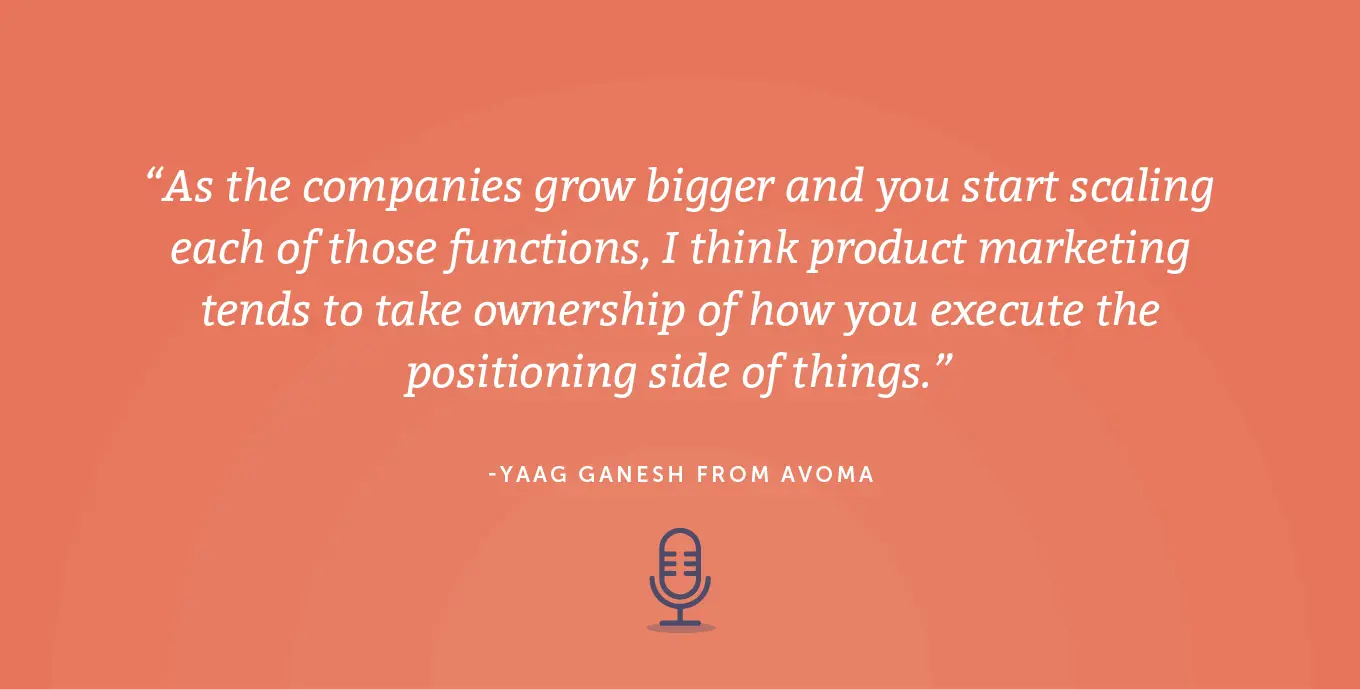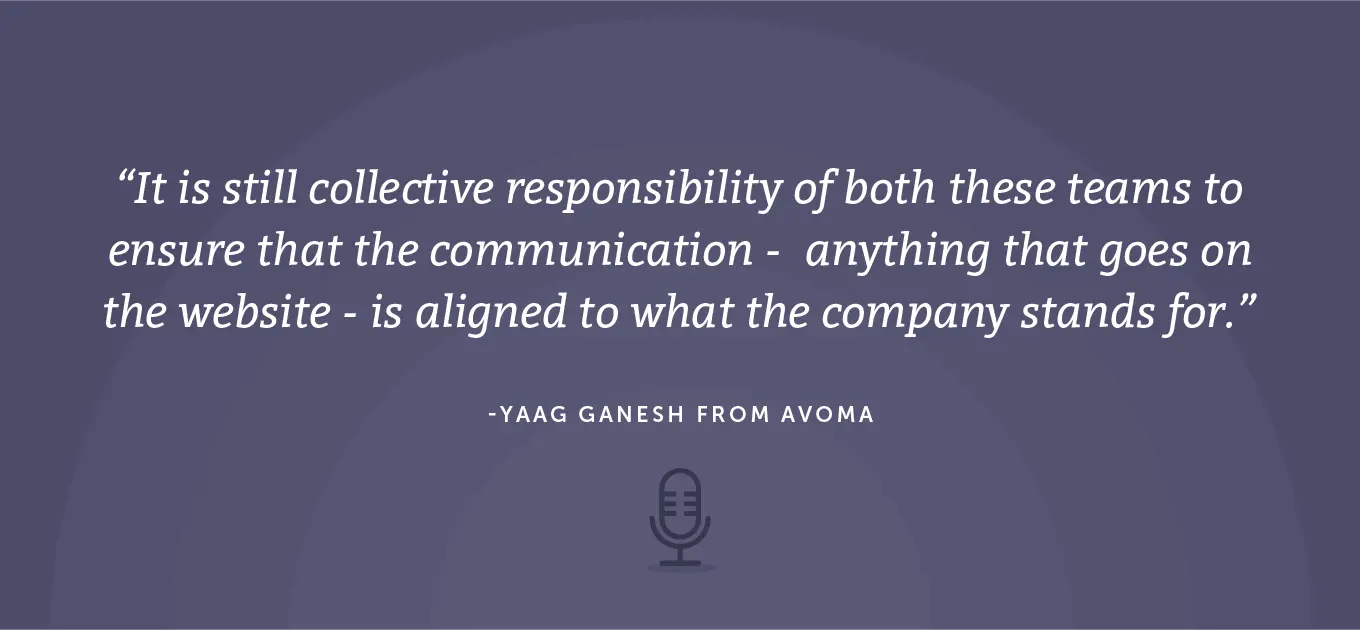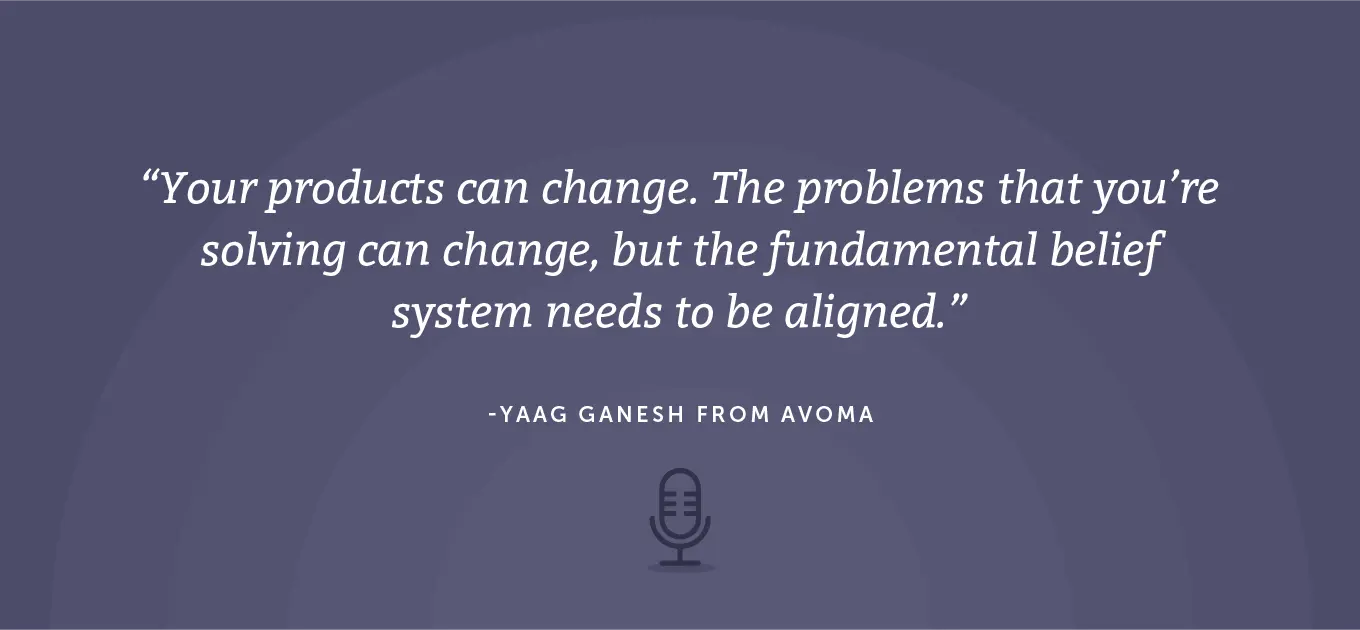How Content Marketing and Product Marketing Teams Can Work Together to Achieve Incredible Results With Yaagneshwaran Ganesh From Avoma [AMP 258]
 How can content marketing and product marketing teams have different goals and responsibilities, but still work together to achieve incredible results and help their companies grow?
Today’s guest is Yaagneshwaran Ganesh from Avoma, a leading management, collaboration, and AI assistant platform. Yaag talks about how content and product marketing teams can best collaborate and work together toward shared objectives to drive top performance.
Some of the highlights of the show include:
How can content marketing and product marketing teams have different goals and responsibilities, but still work together to achieve incredible results and help their companies grow?
Today’s guest is Yaagneshwaran Ganesh from Avoma, a leading management, collaboration, and AI assistant platform. Yaag talks about how content and product marketing teams can best collaborate and work together toward shared objectives to drive top performance.
Some of the highlights of the show include:
- Roles and Responsibilities: Depends on size of organization
- Product Features: Ensure customer awareness and adoption
- Content Friction: Are you writing for the customer, prospect, or bot?
- Consequences: Content experience brings people closer or further from brand
- Brand Impact: What and whose problem are you solving? Seek and gain clarity
- Common Goals: Consider entire journey to fill in gaps, achieve cohesive results
- Team Sport: Speak same language to understand and align culture, purpose
- “As the companies grow bigger and you start scaling each of those functions, I think product marketing tends to take ownership of how you execute the positioning side of things.”
- “It is still collective responsibility of both these teams to ensure that the communication - anything that goes on the website - is aligned to what the company stands for.”
- “With every of these touchpoints, people are either coming towards your brand or they’re getting deflected away.”
- “Your products can change. The problems that you’re solving can change, but the fundamental belief system needs to be aligned.”
How Content Marketing and Product Marketing Teams Can Work Together to Achieve Incredible Results With Yaag Ganesh From Avoma
Click To Tweet Some other teams keep content marketing separate where they're primarily focused on blogs and top-of-the-funnel content. It really depends, but overall, I would think these two teams both go hand in hand. It is the collective responsibility of both these teams to ensure that the communication, anything that goes on the website is aligned to what the company stands for the messaging they want to give. But primarily, I would say that product marketing is one thing that needs to not only look at this but also understand that you talk the product language as well.
Some other teams keep content marketing separate where they're primarily focused on blogs and top-of-the-funnel content. It really depends, but overall, I would think these two teams both go hand in hand. It is the collective responsibility of both these teams to ensure that the communication, anything that goes on the website is aligned to what the company stands for the messaging they want to give. But primarily, I would say that product marketing is one thing that needs to not only look at this but also understand that you talk the product language as well.
 In a sense, they need to be the liaison between the product team and the marketing team and ensure that every customer is aware of the different features of the product. Adoption is also going well. Because many times I've seen this case where you might get some feature requests from your customers that you often hear, customer success calls.
These could be features that exist in your product and the customers are not aware of it. That's a fundamental product marketing problem that the team needs to solve. That's the broad outline of the way I look at it.
Ben: Sure, yeah. I think that's a pretty clear breakdown between the two teams, for sure. In your view, possibly in your own experience as well, what are some common causes of friction that can occur between content and product marketing teams? What are some common points where maybe those two teams don't always work together as well as what they really should?
Yaag: This happens quite a lot. As companies grow bigger, you see that there is one side of the house, which is working on continuously churning all different pieces of content. The other side of the house is not even using the content properly. For example, you have a sales team who is not aware of this content or the product team, which is not necessarily articulating what is needed for your organization to keep things going.
Fundamentally, the question is, are you writing for the customer, are you writing for the prospect, or are you just writing for both? It might sound obvious, but here's the point. When you look at a content marketing team, if they are primarily going after the keyword recommendation that comes from your SEO team and they are just building content on top of that, it does not help anyone. Sometimes what happens is we tend to take inspiration from companies of different sizes and that doesn't make sense to us at all.
For example, if I were to go and copy what HubSpot is doing, it would not make sense for me. For example, they write an article on how to make a GIF, it does not make sense to me. It does not make sense to HubSpot, if you look at it. But because they are playing at a different scale, they are attracting different kinds of people.
For example, in my case, it's a small organization and I have two people in the sales team. Predominantly, what I want to do is I want to make sure that every demand that is generated, that is sensible, that has a clear need for the product, and I'm attracting the right audience. To me, as a content marketing team, the first thing that I would do is go back and listen to some of those customer conversations and prospect conversations, and then bring those inputs into what I can create and what are the kinds of questions that these guys are regularly asking my [...] and CSMs. Then do a quick search on Ahrefs or SEMush, and then combine these two and create it.
If people are doing it this way, then that wouldn't be much friction with the product marketing team because you're aligned with who your customers are. If you're going to be working on different spectrums, not talking to each other, and having totally different goals, then you're going to be sandbagging yourself to that goal that is set by your team. Ultimately, it does not matter for the teams to collaborate with each other. That's where every friction begins.
Ben: Yeah, for sure. I think that's a really pretty clear explanation there of where things tend to break down between one team that's very customer-focused and one team that might have a tendency to be...
Yaag: Going after traffic, volume, and things like that.
Ben: Yeah, chasing ghosts a little bit. I think that's a great answer. As a result of that friction, which really occurs between the push and pull between wanting to attract lots of people versus attracting the right people versus getting the right content to the right people at the right time. That work being spread out between multiple teams with different goals. What are some of the negative consequences that you've experienced as a result?
It's one thing if content and product marketing struggle to work together. That's a problem unto itself. But looking at it more broadly, if they're not working well together, that could really have some serious negative ramifications for the company beyond just wasted time and resources. In your view, what are the negative consequences? Why should people be concerned about this?
Yaag: To put it in the most simplest sense, what would happen is, imagine there are three or four people on your content team and there are different sets of people working on your product marketing team. At the end of the day, one thing we need to remember is that every experience that people have with your brand, be with your content, the experience on the website, or they're meeting you in a booth—booth, of course, pre-COVID, not now much. What happens is with every one of these touchpoints, people are either coming towards your brand or they are getting deflected away.
In a sense, they need to be the liaison between the product team and the marketing team and ensure that every customer is aware of the different features of the product. Adoption is also going well. Because many times I've seen this case where you might get some feature requests from your customers that you often hear, customer success calls.
These could be features that exist in your product and the customers are not aware of it. That's a fundamental product marketing problem that the team needs to solve. That's the broad outline of the way I look at it.
Ben: Sure, yeah. I think that's a pretty clear breakdown between the two teams, for sure. In your view, possibly in your own experience as well, what are some common causes of friction that can occur between content and product marketing teams? What are some common points where maybe those two teams don't always work together as well as what they really should?
Yaag: This happens quite a lot. As companies grow bigger, you see that there is one side of the house, which is working on continuously churning all different pieces of content. The other side of the house is not even using the content properly. For example, you have a sales team who is not aware of this content or the product team, which is not necessarily articulating what is needed for your organization to keep things going.
Fundamentally, the question is, are you writing for the customer, are you writing for the prospect, or are you just writing for both? It might sound obvious, but here's the point. When you look at a content marketing team, if they are primarily going after the keyword recommendation that comes from your SEO team and they are just building content on top of that, it does not help anyone. Sometimes what happens is we tend to take inspiration from companies of different sizes and that doesn't make sense to us at all.
For example, if I were to go and copy what HubSpot is doing, it would not make sense for me. For example, they write an article on how to make a GIF, it does not make sense to me. It does not make sense to HubSpot, if you look at it. But because they are playing at a different scale, they are attracting different kinds of people.
For example, in my case, it's a small organization and I have two people in the sales team. Predominantly, what I want to do is I want to make sure that every demand that is generated, that is sensible, that has a clear need for the product, and I'm attracting the right audience. To me, as a content marketing team, the first thing that I would do is go back and listen to some of those customer conversations and prospect conversations, and then bring those inputs into what I can create and what are the kinds of questions that these guys are regularly asking my [...] and CSMs. Then do a quick search on Ahrefs or SEMush, and then combine these two and create it.
If people are doing it this way, then that wouldn't be much friction with the product marketing team because you're aligned with who your customers are. If you're going to be working on different spectrums, not talking to each other, and having totally different goals, then you're going to be sandbagging yourself to that goal that is set by your team. Ultimately, it does not matter for the teams to collaborate with each other. That's where every friction begins.
Ben: Yeah, for sure. I think that's a really pretty clear explanation there of where things tend to break down between one team that's very customer-focused and one team that might have a tendency to be...
Yaag: Going after traffic, volume, and things like that.
Ben: Yeah, chasing ghosts a little bit. I think that's a great answer. As a result of that friction, which really occurs between the push and pull between wanting to attract lots of people versus attracting the right people versus getting the right content to the right people at the right time. That work being spread out between multiple teams with different goals. What are some of the negative consequences that you've experienced as a result?
It's one thing if content and product marketing struggle to work together. That's a problem unto itself. But looking at it more broadly, if they're not working well together, that could really have some serious negative ramifications for the company beyond just wasted time and resources. In your view, what are the negative consequences? Why should people be concerned about this?
Yaag: To put it in the most simplest sense, what would happen is, imagine there are three or four people on your content team and there are different sets of people working on your product marketing team. At the end of the day, one thing we need to remember is that every experience that people have with your brand, be with your content, the experience on the website, or they're meeting you in a booth—booth, of course, pre-COVID, not now much. What happens is with every one of these touchpoints, people are either coming towards your brand or they are getting deflected away.
 If your content marketing team is going to work on a different set of things that sounds very different, then at the end of the day, it's going to feel like you as a customer are talking to two different companies. Or probably, if everyone is writing things in their own way and going after their own goals, it's going to feel very, very different. It's not going to give the same brand impact. At the end of the day, even when you look at specific content written, there needs to be one line of clarity as to who is it for.
I'm not talking about who is it for in the sense of purely, say, the customer persona, but I'm talking about whose problem are you solving. At least, what problem are you solving? If that is not clear and if that's not universally agreed upon within the organization, then everybody is going to convert their own favorite feature into a problem statement and talk about solutions for that particular statement, and that is not helping.
At the end of the day, if you don't know what you're solving for, at least what is the DNA of your organization? When I say DNA, today you are solving for this using XYZ feature, tomorrow it could be something else. But the DNA is that I do this this way because my organization believes this. Think of the way when Salesforce came in, they were all about the cloud. They said cloud is going to be the future. That's what I'm looking at.
Everything that they did was banking on that particular DNA. It started with CRM. Today, they have ended in a totally different place. Your products can change. The problems that you're solving can change, but the fundamental belief system needs to be aligned. If that's not happening, it's going to be a very bad experience. That's the first point.
If your content marketing team is going to work on a different set of things that sounds very different, then at the end of the day, it's going to feel like you as a customer are talking to two different companies. Or probably, if everyone is writing things in their own way and going after their own goals, it's going to feel very, very different. It's not going to give the same brand impact. At the end of the day, even when you look at specific content written, there needs to be one line of clarity as to who is it for.
I'm not talking about who is it for in the sense of purely, say, the customer persona, but I'm talking about whose problem are you solving. At least, what problem are you solving? If that is not clear and if that's not universally agreed upon within the organization, then everybody is going to convert their own favorite feature into a problem statement and talk about solutions for that particular statement, and that is not helping.
At the end of the day, if you don't know what you're solving for, at least what is the DNA of your organization? When I say DNA, today you are solving for this using XYZ feature, tomorrow it could be something else. But the DNA is that I do this this way because my organization believes this. Think of the way when Salesforce came in, they were all about the cloud. They said cloud is going to be the future. That's what I'm looking at.
Everything that they did was banking on that particular DNA. It started with CRM. Today, they have ended in a totally different place. Your products can change. The problems that you're solving can change, but the fundamental belief system needs to be aligned. If that's not happening, it's going to be a very bad experience. That's the first point.
 Second thing is that you also need to be aligned on some common goals across the organization. If you're seeing certain companies look at it as rev ops, certain companies look at it as sales ops, marketing ops, but think about it more as CS ops. It is not sales ops, or marketing ops, or customer success ops, but you're looking at the entire journey, and looking at different gaps, and trying to plug all those things. It's like picking different flowers and building a beautiful garden.
That's what you want to do. If that's not happening, then you are going to see information loss, conversation loss, different data leaks, nobody talking to each other. Ultimately, what happens is 10 different teams reaching out to the same customer talking about 12 different things. Ultimately, it's not going to end well.
Ben: Right. It doesn't result in a very cohesive experience for a customer. I think we've all probably experienced this, probably, at least once in dealing with a company where it's maybe been evident that this type of breakdown was maybe going on.
If content and product marketing teams, if they want to begin building a more positive working relationship or even if they do have a good working relationship, if they want to improve that relationship or just better collaborate with one another, how would you recommend they go about leveraging the strengths of each side in order to help grow their organization and really provide customers with a more cohesive experience that's going to make them more likely to want to buy?
Yaag: One of the core things is that we need to look at having common goals across both the teams. Once that is established, then we look at what part of the puzzle am I solving? What is my strength where I can solve for? At a smaller organization, everybody might be doing everything and might be even filling for each other wherever required. But as you grow, you need to set up a process. That process needs to be helping you to scale.
Fundamentally, there need to be some systems in place where everybody—it could be a simple OKR system, for example. You need to very clearly have a common objective and key results for your entire marketing department, then break it down to the OKR for your product marketing team, see where the content team fits in, and then specifically give them that system.
In fact, to tell you a story, when I first joined Avoma sometime in early April, I had this question because I'm going to be a one-person team at that time, and what should I solve for? One of the first things that my CEO told me was, hey, Yaag, don't worry about how much traffic you're going to bring in or how many leads you're going to bring in, none of those are going to be your goals. Simply do good marketing and let things compound over a period of time. Just make sure that everything that we do, every piece of content that you write, or every person that you reach out to, try to give the best possible experience.
By experience, it includes even the kind of words we use while we speak. Now I've become so cognizant of it that when I write for Avoma, every single word I know if this is how Avoma talks or not. That piece comes into every piece of thing that I do. Eventually, what you do there is that it also starts helping you in your hiring process to pick people that align to that kind of culture, who come from being proactive or understanding what the company needs, where to fit in, and all of that.
One is having a common goal. Second is also building the right team, having the right mindset, and keeping everything open. Transparency is super important in this kind of setup as well. Today that we are all working in a remote kind of environment, it becomes more and more difficult where you cannot walk up to each other and tap them on the shoulder and say, hey, let's go for a coffee, have a conversation, and sort things out. That's not going to happen now.
You need to be able to quickly build relationships across the board. In fact, I've heard Kris Rudeegraap of Sendoso talking about team selling as a concept. I think this is also a team sport. When you look at marketing, you definitely cannot have silos. That needs to be first broken down.
Ben: Yeah, for sure. Definitely an advocate for breaking down silos. They benefit no one.
Yaag: Yes.
Ben: The last question I'll throw your way. The content and product marketing teams within an organization, once they're working well with one another, what kinds of benefits or results could they expect to drive? I really feel like this is just looking at some of the questions I've asked earlier about problems and consequences. Let's just look at that from the inverse perspective. When things are going well, what does that look like for the company?
Yaag: Great. As I said, when things are going well, it would look like you're not talking to different people. It feels like you're talking to one brand and the experience is universal across different touchpoints. The second is the execution is actually really fast. In essence, everybody knows what to do. More importantly, everyone knows why they are doing what they're doing.
Otherwise, what happens is if you're blindly following a structure to do certain things in a way, it doesn't help anyone because when something changes, if you were used to doing events in person and COVID happened, you needed to adapt to a virtual event. You need to know the purpose and then you start to evolve things based on what's happening in the market. Ultimately, I think everyone will know their purpose, everyone will give up one unified experience. But more importantly, you will also accelerate faster as an organization.
There will be feedback loops, but they will be more asynchronous. It'll be, for example, me listening to a conversation and quickly commenting right there on the transcript and saying, hey, you know what, let's fix it this way. I don't have to schedule more meetings, go through the entire thing, explain why this is a problem, and all of that. Things become very, very contextual. You start accelerating across the board.
Ben: Sure, yeah. That's a very succinct, very clear explanation for what was the goal, what's the end state to bringing these two sides together. I think that really sums up things pretty well. Yaag, this has been awesome. If people want to find you on the web or Avoma, where would you recommend they go look?
Yaag: For anything related to Avoma, you can just reach out to me either on LinkedIn or my email, which is yaag@avoma.com. I'm easiest to find on LinkedIn. You can also just Google my name. It's unique. I'm probably the only person with that name. You can easily find me online. I'm happy to talk or discuss anything around marketing and sales. I'm very passionate about that. Feel free to hit me up and I'll be happy to catch up.
Ben: Very cool. Thanks so much for coming on the show. I know I got a lot out of this conversation. I'm sure our listeners will as well.
Second thing is that you also need to be aligned on some common goals across the organization. If you're seeing certain companies look at it as rev ops, certain companies look at it as sales ops, marketing ops, but think about it more as CS ops. It is not sales ops, or marketing ops, or customer success ops, but you're looking at the entire journey, and looking at different gaps, and trying to plug all those things. It's like picking different flowers and building a beautiful garden.
That's what you want to do. If that's not happening, then you are going to see information loss, conversation loss, different data leaks, nobody talking to each other. Ultimately, what happens is 10 different teams reaching out to the same customer talking about 12 different things. Ultimately, it's not going to end well.
Ben: Right. It doesn't result in a very cohesive experience for a customer. I think we've all probably experienced this, probably, at least once in dealing with a company where it's maybe been evident that this type of breakdown was maybe going on.
If content and product marketing teams, if they want to begin building a more positive working relationship or even if they do have a good working relationship, if they want to improve that relationship or just better collaborate with one another, how would you recommend they go about leveraging the strengths of each side in order to help grow their organization and really provide customers with a more cohesive experience that's going to make them more likely to want to buy?
Yaag: One of the core things is that we need to look at having common goals across both the teams. Once that is established, then we look at what part of the puzzle am I solving? What is my strength where I can solve for? At a smaller organization, everybody might be doing everything and might be even filling for each other wherever required. But as you grow, you need to set up a process. That process needs to be helping you to scale.
Fundamentally, there need to be some systems in place where everybody—it could be a simple OKR system, for example. You need to very clearly have a common objective and key results for your entire marketing department, then break it down to the OKR for your product marketing team, see where the content team fits in, and then specifically give them that system.
In fact, to tell you a story, when I first joined Avoma sometime in early April, I had this question because I'm going to be a one-person team at that time, and what should I solve for? One of the first things that my CEO told me was, hey, Yaag, don't worry about how much traffic you're going to bring in or how many leads you're going to bring in, none of those are going to be your goals. Simply do good marketing and let things compound over a period of time. Just make sure that everything that we do, every piece of content that you write, or every person that you reach out to, try to give the best possible experience.
By experience, it includes even the kind of words we use while we speak. Now I've become so cognizant of it that when I write for Avoma, every single word I know if this is how Avoma talks or not. That piece comes into every piece of thing that I do. Eventually, what you do there is that it also starts helping you in your hiring process to pick people that align to that kind of culture, who come from being proactive or understanding what the company needs, where to fit in, and all of that.
One is having a common goal. Second is also building the right team, having the right mindset, and keeping everything open. Transparency is super important in this kind of setup as well. Today that we are all working in a remote kind of environment, it becomes more and more difficult where you cannot walk up to each other and tap them on the shoulder and say, hey, let's go for a coffee, have a conversation, and sort things out. That's not going to happen now.
You need to be able to quickly build relationships across the board. In fact, I've heard Kris Rudeegraap of Sendoso talking about team selling as a concept. I think this is also a team sport. When you look at marketing, you definitely cannot have silos. That needs to be first broken down.
Ben: Yeah, for sure. Definitely an advocate for breaking down silos. They benefit no one.
Yaag: Yes.
Ben: The last question I'll throw your way. The content and product marketing teams within an organization, once they're working well with one another, what kinds of benefits or results could they expect to drive? I really feel like this is just looking at some of the questions I've asked earlier about problems and consequences. Let's just look at that from the inverse perspective. When things are going well, what does that look like for the company?
Yaag: Great. As I said, when things are going well, it would look like you're not talking to different people. It feels like you're talking to one brand and the experience is universal across different touchpoints. The second is the execution is actually really fast. In essence, everybody knows what to do. More importantly, everyone knows why they are doing what they're doing.
Otherwise, what happens is if you're blindly following a structure to do certain things in a way, it doesn't help anyone because when something changes, if you were used to doing events in person and COVID happened, you needed to adapt to a virtual event. You need to know the purpose and then you start to evolve things based on what's happening in the market. Ultimately, I think everyone will know their purpose, everyone will give up one unified experience. But more importantly, you will also accelerate faster as an organization.
There will be feedback loops, but they will be more asynchronous. It'll be, for example, me listening to a conversation and quickly commenting right there on the transcript and saying, hey, you know what, let's fix it this way. I don't have to schedule more meetings, go through the entire thing, explain why this is a problem, and all of that. Things become very, very contextual. You start accelerating across the board.
Ben: Sure, yeah. That's a very succinct, very clear explanation for what was the goal, what's the end state to bringing these two sides together. I think that really sums up things pretty well. Yaag, this has been awesome. If people want to find you on the web or Avoma, where would you recommend they go look?
Yaag: For anything related to Avoma, you can just reach out to me either on LinkedIn or my email, which is yaag@avoma.com. I'm easiest to find on LinkedIn. You can also just Google my name. It's unique. I'm probably the only person with that name. You can easily find me online. I'm happy to talk or discuss anything around marketing and sales. I'm very passionate about that. Feel free to hit me up and I'll be happy to catch up.
Ben: Very cool. Thanks so much for coming on the show. I know I got a lot out of this conversation. I'm sure our listeners will as well.




